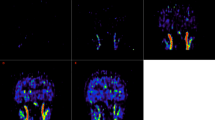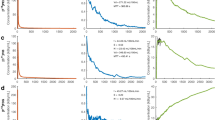Abstract
The arterial concentration of the radiopharmaceutical \({}^{18}\text {F}\)-choline is needed to estimate its absorption by tumors and other tissues. The blood concentration of \({}^{18}\text {F}\)-choline changes as it interacts with tissues, and so it is represented as a function with respect to time, the so-called Input Function (IF). In this paper, we present the estimation of an arterial whole-blood Image-Derived Input Function (IDIF) from the PET image, needed to model its absorption. The sagittal and transverse brain venous sinuses are automatically segmented based on the top-hat morphological transform. Such segmentation provides an estimation of the venous whole-blood IDIF. It is then corrected to obtain the arterial whole-blood IDIF by relating the amount of radioactivity material entering the brain region with the amount leaving it and the amount remaining. We compare the automatic venous whole-blood IDIF with a whole-blood venous IDIF from a region manually segmented. Also, we compare the automatic arterial whole-blood IDIF with the arterial IF obtained with serial blood samples on the radial artery. Quantitative measures indicate the overall accuracy of the estimation.
This work was supported by the project 2015 PI15-01653 of the Carlos III Health Institute and by the project TIN 2016-75404-P AEI/FEDER.
Access this chapter
Tax calculation will be finalised at checkout
Purchases are for personal use only
Similar content being viewed by others
References
Bibiloni, P., González-Hidalgo, M., Massanet, S.: A survey on curvilinear object segmentation in multiple applications. Pattern Recognit. 60, 949–970 (2016)
Hammers, A., et al.: Three-dimensional maximum probability atlas of the human brain, with particular reference to the temporal lobe. Hum. Brain Mapp. 19(4), 224–247 (2003)
Lassen, N.A.: Normal average value of cerebral blood flow in younger adults is 50 ml/100 g/min (1985)
Louis, D.N., et al.: The 2007 who classification of tumours of the central nervous system. Acta Neuropathol. 114(2), 97–109 (2007)
Rubí, S., Bibiloni, P., Galmés, M., et al.: PET kinetic modeling with arterial sampling of 18F-choline uptake in patients with a suspected initial diagnosis of high grade glioma. In: 30th Annual Congress of the European Association of Nuclear Medicine (EANM 2017) (2017)
Schiepers, C., Chen, W., Dahlbom, M., Cloughesy, T., Hoh, C.K., Huang, S.C.: 18F-fluorothymidine kinetics of malignant brain tumors. Eur. J. Nucl. Med. Imaging 34(7), 1003–1011 (2007)
Siegal, T.: Clinical impact of molecular biomarkers in gliomas. J. Clini. Neurosci. 22(3), 437–444 (2015)
Verwer, E.E., et al.: Quantification of 18F-fluorocholine kinetics in patients with prostate cancer. J. Nucl. Med. 56(3), 365–371 (2015)
Wahl, L.M., Asselin, M.C., Nahmias, C.: Regions of interest in the venous sinuses as input functions for quantitative PET. J. Nucl. Med. 40(10), 1666–1675 (1999)
Zanotti-Fregonara, P., Chen, K., Liow, J.S., Fujita, M., Innis, R.B.: Image-derived input function for brain pet studies: many challenges and few opportunities. J. Cereb. Blood Flow Metab. 31(10), 1986–1998 (2011)
Author information
Authors and Affiliations
Corresponding author
Editor information
Editors and Affiliations
Rights and permissions
Copyright information
© 2019 Springer Nature Switzerland AG
About this paper
Cite this paper
González, C., Bibiloni, P., González-Hidalgo, M., Mir, A., Rubí, S. (2019). Automatic Image-Derived Estimation of the Arterial Whole-Blood Input Function from Dynamic Cerebral PET with \(^{18}\)F-Choline. In: Riaño, D., Wilk, S., ten Teije, A. (eds) Artificial Intelligence in Medicine. AIME 2019. Lecture Notes in Computer Science(), vol 11526. Springer, Cham. https://doi.org/10.1007/978-3-030-21642-9_43
Download citation
DOI: https://doi.org/10.1007/978-3-030-21642-9_43
Published:
Publisher Name: Springer, Cham
Print ISBN: 978-3-030-21641-2
Online ISBN: 978-3-030-21642-9
eBook Packages: Computer ScienceComputer Science (R0)




